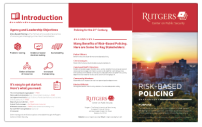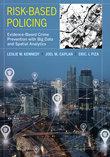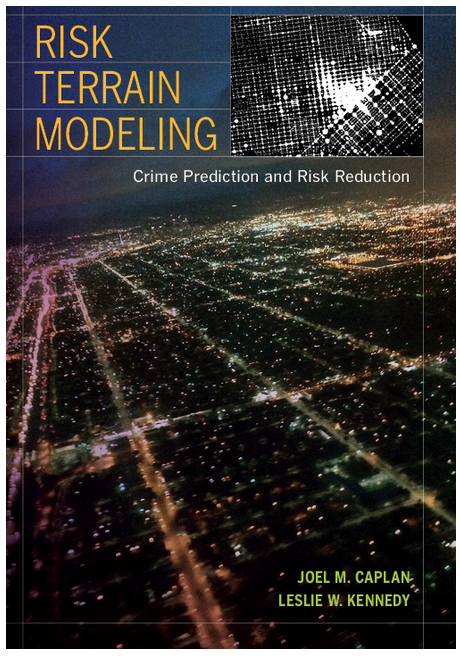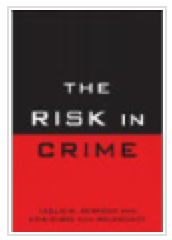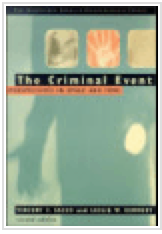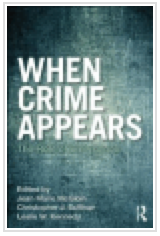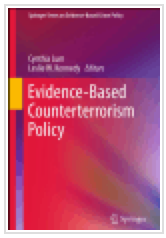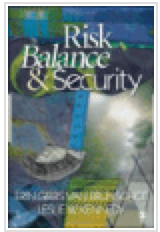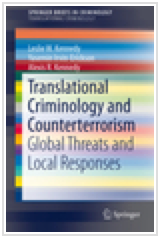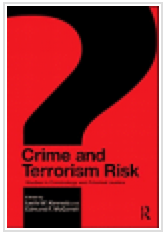The following items were produced in direct association with RCPS
Look for the symbols to quickly find your interest
Look for the symbols to quickly find your interest
Printed by RCPS
Free Downloads
Free Downloads
Books
Kennedy, L. W., Caplan, J. M. & Piza, E. L. (2018). Risk-Based Policing: Evidence-Based Crime Prevention with Big Data and Spatial Analytics. Link
Caplan, J. M. & Kennedy, L. W. (2016). Risk Terrain Modeling: Crime Prediction and Risk Reduction. CA: Univ. of California Press. Link | Google Preview
Kennedy, L. W., Irvin-Erickson, Y. & Kennedy, A. R. (2014). Translational Criminology and Counterterrorism. NY: Springer. Link
Lum, C. & Kennedy, L.W. (2011). Evidence Based Counterterrorism Policy. N.Y.: Springer. Link
McGloin, J. M., Sullivan, C.J., & Kennedy, L.W. (2011). When Crime Appears: The Role of Emergence. N.Y.: Routledge. Link
Kennedy, L. W. & McGarrell, E. F. (Eds.). (2011). Crime and Terrorism Risk: Studies in Criminology and Criminal Justice. New York: Routledge. Link
Kennedy, L. W. & Van Brunschot, E. (2009), The Risk in Crime. NY: Rowman and Littlefield. Link
Van Brunschot, E. & Kennedy, L. W. (2008). Risk Balance and Security. Thousand Oaks, CA: Sage Publications. Link
Sacco, V. & Kennedy, L. W. (2001). The Criminal Event: Perspectives in Space and Time (2nd Edition). Wadsworth. Link
Kennedy, L. W., Caplan, J. M. & Piza, E. L. (2018). Risk-Based Policing: Evidence-Based Crime Prevention with Big Data and Spatial Analytics. Link
Caplan, J. M. & Kennedy, L. W. (2016). Risk Terrain Modeling: Crime Prediction and Risk Reduction. CA: Univ. of California Press. Link | Google Preview
Kennedy, L. W., Irvin-Erickson, Y. & Kennedy, A. R. (2014). Translational Criminology and Counterterrorism. NY: Springer. Link
Lum, C. & Kennedy, L.W. (2011). Evidence Based Counterterrorism Policy. N.Y.: Springer. Link
McGloin, J. M., Sullivan, C.J., & Kennedy, L.W. (2011). When Crime Appears: The Role of Emergence. N.Y.: Routledge. Link
Kennedy, L. W. & McGarrell, E. F. (Eds.). (2011). Crime and Terrorism Risk: Studies in Criminology and Criminal Justice. New York: Routledge. Link
Kennedy, L. W. & Van Brunschot, E. (2009), The Risk in Crime. NY: Rowman and Littlefield. Link
Van Brunschot, E. & Kennedy, L. W. (2008). Risk Balance and Security. Thousand Oaks, CA: Sage Publications. Link
Sacco, V. & Kennedy, L. W. (2001). The Criminal Event: Perspectives in Space and Time (2nd Edition). Wadsworth. Link
Book Chapters

2014. Forecasting of Shootings using Risk Terrain Modeling. In G. Bruinsma and D. Weisburd (Eds.), Crime and Place: Crime Specialization and Concentrations. New York: Springer-Verlag. Link

2012. Countering the Threat of Terrorism: Applying Risk Terrain Modeling in Turkish Cities. In C. Lum and L. Kennedy (Eds.), Evidence-Based Counterterrorism Policy. New York: Springer-Verlag. Link

2011. Risk Terrains and Crime Emergence. In J. McGloin, C. Sullivan, and L. W. Kennedy. When Crime Appears: The Role of Crime Emergence. NY: Taylor & Francis. Link

2011. Forecasting Global Maritime Piracy Utilizing the Risk Terrain Modeling (RTM) Approach to Spatial Risk Assessment. In L. W. Kennedy and E. F. McGarrell (Eds.), Crime and Terrorism Risk: Studies in Criminology and Criminal Justice. NY: Routledge. Link
Journal Articles

2018. Enhancing Data-Driven Law Enforcement Efforts: Exploring how Risk Terrain Modeling and Conjunctive Analysis Fit in a Crime and Traffic Safety Framework. American Journal of Criminal Justice. Link

2018. Utilizing a Risk of Crime Measure for Recidivism Research: Moving Environmental Corrections Forward. Crime & Delinquency. Link

2018. Predicting Dynamical Crime Distribution from Environmental and Social Influences. Frontiers in Applied Mathematics and Statistics. Link

2018. Examining Interactive Effects of Characteristics of the Social and Physical Environment on Aggravated Assault. Journal of Criminal Justice. Link

2018. Risk Terrain Modeling and Socio-Economic Stratification: Identifying Risky Places for Violent Crime Victimization in Bogotá, Colombia. European Journal of Criminal Policy and Research. Link

2018. Facilitators and Impediments to Designing, Implementing, and Evaluating Risk-Based Policing Strategies Using Risk Terrain Modeling: Insights from a Multi-City Evaluation in the United States. European Journal of Criminal Policy and Research. Link

2017. Crime in Context: Utilizing Risk Terrain Modeling and Conjunctive Analysis of Case Configurations to Explore the Dynamics of Criminogenic Behavior Settings. Journal of Contemporary Criminal Justice. Link

2017. The Crime Kaleidoscope: A Cross-Jurisdictional Analysis of Place Features and Crime in Three Urban Environments. Applied Geography. Link

2017. Place-Based Risk Factors for Aggravated Assault Across Police Divisions in Little Rock, Arkansas. Journal of Crime and Justice. Link

2017. CCTV as a Tool for Early Police Intervention: Preliminary Lessons from Nine Case Studies. Security Journal. Link

2016. Place-Based Correlates of Motor Vehicle Theft and Recovery: Measuring Spatial Influence Across Neighbourhood Context. Urban Studies. Link

2016. Bringing the Physical Environment Back Into Neighborhood Research: The Utility of RTM for Developing an Aggregate Neighborhood Risk of Crime Measure. Journal of Criminal Justice. Link

2015. The Social and Geographic Patterns of Sexual Offending: Is Sexual Offender Residence Restriction Legislation Practical?. Victims & Offenders. Link

2015. Exposure to Crime: Applying Risk Terrain Modeling to the Study of Assault in Chicago. Applied Spatial Analysis and Policy. Link | View Brief

2014. Spatial Risk Factors of Felonious Battery to Police Officers. Policing. Link

In Press. Assessing the Effects of Local Crime Hotspots on Parolee Recidivism. Prison Journal.

2014. The Effects of Merging Proactive CCTV Monitoring with Directed Police Patrol: A Randomized Control Trial. Journal of Experimental Criminology. Link

2015. Risk Terrain Modeling for Spatial Risk Assessment. Cityscape, 17(1), 7-16. Link

2014. Risk Terrain Modeling for Strategic and Tactical Action. Crime Mapping & Analysis News. Link

2014. Analyzing the Influence of Micro-Level Factors on CCTV Camera Effect. Journal of Quantitative Criminology, 30(2). Link

2013. ‘A plague on both your houses?’: Risks, repeats and reconsiderations of urban residential burglary. Justice Quarterly. Link

2013. Home nodes, criminogenic places, and parolee failure: Testing an environmental model of offender risk. Crime and Delinquency. Link

2013. Joint utility of event-dependent and environmental crime analysis techniques for violent crime forecasting. Crime and Delinquency, 59(2), 243-270. Link

2012. Kansas City’s Violent Crime Initiative: A Place-Based Evaluation of Location-Specific Intervention Activities during a Fixed Time Period. Crime Mapping, 4(2), 9-37. Link

2012. Is the punishment more certain?: An analysis of CCTV detections and enforcement. Justice Quarterly. Link

2011. Mapping the spatial influence of crime correlates: A comparison of operationalization schemes and implications for crime analysis and criminal justice practice. Cityscape, 13(3), 57-83. PDF

2011. Police-monitored CCTV cameras in Newark, NJ: A quasi-experimental test of crime deterrence. Journal of Experimental Criminology, 7, 255-274. Link

2011. Risk terrain modeling: Brokering criminological theory and GIS methods for crime forecasting. Justice Quarterly, 28(2), 360-381. Link

2011. Risk clusters, hotspots, and spatial intelligence: Risk Terrain Modeling as an Algorithm for Police Resource Allocation Strategies. Journal of Quantitative Criminology, 27(3), 339-362. Link

2010. National surveys of state paroling authorities: Models of service delivery. Federal Probation, 74(1), 34-42. PDF

2008. Using GIS to evaluate post-release prisoner services in Newark, New Jersey. Journal of Criminal Justice, 36(5), 416-425. PDF
Working Papers, Reports and Research Briefs

2018. Unpacking Spatio-Temporal Differences of Risk for Crime: An Analysis in Little Rock, Arkansas PDF

2018. Risk-Based Policing in Atlantic City: 2017 Report PDF

2017. Crime in Context: Utilizing Risk Terrain Modeling and Conjunctive Analysis to Explore the Dynamics of Criminogenic Behavior Settings PDF

2017. The Atlantic City Police Department Risk-Based Policing Initiative Pilot Project: 2016 Year-End Report PDF

2017. Place-Based Risk Factors for Aggravated Assault Across Police Divisions in Little Rock, Arkansas PDF

2017. The Crime Kaleidoscope: A Cross-Jurisdictional Analysis of Place Features and Crime in Three Urban Environments PDF

2016. Examining the Environmental Characteristics of Drug Dealing Locations PDF

2016. Exposure to Crime: Applying Risk Terrain Modeling to the Study of Assault in Chicago (Theory of Risky Places) PDF

2016. Bringing the Physical Environ. Back Into Neighborhood Research: The Utility of RTM for Developing an Aggregate Neighborhood Risk of Crime Measure PDF

2015. A Multi-jurisdictional Test of Risk Terrain Modeling and a Place-based Evaluation of Environmental Risk-Based Patrol Deployment Strategies
Final Technical Report (PDF) | Results in Brief (PDF) | ICPSR Archived Data | Proven Strategies Matrix, Case Studies & Tips (PDF) | see also: Conjunctive Analysis Report: 6-City Executive Summary PDF
Final Technical Report (PDF) | Results in Brief (PDF) | ICPSR Archived Data | Proven Strategies Matrix, Case Studies & Tips (PDF) | see also: Conjunctive Analysis Report: 6-City Executive Summary PDF

2013. Felonious Assault and Injury to Law Enforcement: Epidemiology and Spatial Risk Factors PDF

2013. EXECUTIVE SUMMARY. Detection of Crime, Resource Deployment, and Predictors of Success: A Multi-Level Analysis of CCTV in Newark, NJ PDF

2013. Risky Repeats: Using RTM and the Near Repeat Calculator to Analyze Urban Residential Burglary PDF

2012. Robbery Risk as a Co-function of Place and Time PDF

2012. Using Poisson and Negative Binomial Regression Models to Measure the Influence of Risk on Crime Incident Counts PDF

2012. Is the Punishment More Certain? An Analysis of CCTV Detections and Enforcement PDF

2012. Establishing Situational Context in Risk Terrains (with Conjunctive Analysis) PDF

2012. Vacant Properties and Gun Shootings: Empirical Validation of a Core Assumption of the Kensington Renewal Initiative PDF

2012. Weighted Risk Terrain Model for Aggravated Assaults in Kansas City, MO PDF

2012. Risk-Based Intervention Strategy for Policing PDF

2012. Integrating Spatial Crime Analysis Techniques for Tactical and Strategic Actions PDF

2012. A Theory of Risky Places PDF

2011. An Analysis of Modern Early Warning Systems: How might Risk-Terrain Modeling contribute to the development of an optimal system PDF

2011. Applying RTM to Aggravated Assault PDF

2011. Applying RTM to Street Robberies PDF

2010. Practically Meaningful (but Statistically Insignificant) Method for Smoothing Census Data for Inclusion into a Risk Terrain Model PDF

2010. Applying Risk Terrain Modeling to a Violent Crimes Initiative in Kansas City, Missouri PDF

2010. Risk Clusters, Hotspots, and Spatial Intelligence: Risk Terrains Modeling as an Algorithm for Police Resource Allocation Strategies PDF

2010. Risk Terrains of Heart Disease in New Jersey (YouTube Video) Link

2010. Applying RTM to Urban Residential Burglary PDF

2010. Forecasting Global Maritime Piracy Utilizing the Risk Terrain Modeling (RTM) Approach PDF

2009. Police-monitored CCTV cameras in Newark, NJ : Placement choice and their impact on street-level crime incidents PDF

2009. Introduction to Risk Terrain Modeling (RTM) for Strategic Decision-Making and Tactical Action PDF

2009. Risk Terrains as Spatial Intelligence PDF

2009. Applying RTM to Shootings PDF

2009. A Risk Based Outline for Intelligence-Led Policing PDF
Literature Reviews (3 pages or less)

2011. Risk Factors of Shootings PDF

2011. Risk Factors of Aggravated Assaults PDF

2011. Risk Factors of Murder and Non-Negligent Manslaughter PDF

2011. Risk Factors of Drug Dealing in Open-Air Markets PDF

2011. Risk Factors of Street Prostitution PDF

2010. Risk Factors of Sexual Assault PDF

2010. Risk Factors of Forcible Rape PDF

2010. Risk Factors of Auto Thefts PDF

2010. Risk Factors of Urban Residential Burglary PDF

2010. Risk Factors of Street Robbery PDF

2010. Risk Factors of Arson PDF
|

2010. Risk Factors of Simple Assault PDF

2010. Risk Factors of Larceny-Theft PDF

2010. Risk Factors of Loitering PDF

2012. Risk Factors of Smuggling of Migrants PDF

2012. Risk Factors of Gender-based Sexual Violence PDF

2012. Risk Factors of Fragile States PDF

2012. Risk Factors of Natural Resources Security PDF

2012. Risk Factors of Economic Dystopia PDF

2012. Risk Factors of Armed Conflict PDF

2012. Risk Factors of Health PDF

2012. Risk Factors of Unmanaged Migration PDF
|
Conjunctive Analysis

2015. Conjunctive Analysis Report: 6-City Executive Summary PDF

2015. Residential Burglary in Arlington, TX PDF

2015. Shootings in Chicago, IL PDF

2015. Motor Vehicle Theft in Colorado Springs PDF

2015. Robbery in Glendale, AZ PDF

2015. Aggravated Violence in Kansas City, MO PDF

2015. Gun Violence in Newark, NJ PDF

For "how to", see: Conjunctive Analysis Tutorial PDF
Other Recommended Readings (Selected)
ARTICLE. 2018. Gang Violence Predictability: Using Risk Terrain Modeling to Study Gang Homicides and Gang Assaults in East Los Angeles. Journal of Criminal Justice. By Valasik. Link
ARTICLE. 2018. Predicting Property Crime Risk: An Application of Risk Terrain Modeling in Vancouver, Canada. European Journal on Criminal Policy and Research. By Andresen & Hodgkinson. Link
ARTICLE. 2018. Isolating Target and Neighbourhood Vulnerabilities in Crime Forecasting. European Journal on Criminal Policy and Research. By Dugato, Favarin & Bosisio . Link
ARTICLE. 2018. Bus Stops and Violence, Are Risky Places Really Risky? European Journal on Criminal Policy and Research. By Gerell. Link
ARTICLE. 2018. Applying Crime Prediction Techniques to Japan: A Comparison Between Risk Terrain Modeling and Other Methods. European Journal on Criminal Policy and Research. By Ohyama & Amemiya. Link
ARTICLE. 2018. Unpacking Spatio-temporal Differences of Risk for Crime: An Analysis in Little Rock, AR. Policing. By Chillar & Drawve. Link
ARTICLE. 2018. Risk Terrain Modeling for Monitoring Illicit Drugs Markets Across Bogota, Colombia. Crime Science. By Escudero & Ramírez. Link
ARTICLE. 2018. Terrorism Risk Forecasting By Ideology. European Journal on Criminal Policy and Research. By Onat & Gul. Link
ARTICLE. 2018. Measuring the Effect of Heterogeneity of Police Enforcement Actions Across Spatial Contexts. J of Criminal Justice. By Piza & Gilchrist . Link
ARTICLE. 2017. The Role of Crime Analyst and Researcher Partnerships: A Training Exercise in Green Bay, Wisconsin. Policing. By Drawve et al. Link
ARTICLE. 2017. Risky Places: An Analysis of Carjackings in Detroit. Journal of Criminal Justice. By Lersch. Link
ARTICLE. 2017. Forecasting Organized Crime Homicides: Risk Terrain Modeling of Camorra Violence in Naples, Italy. J of Interpersonal Violence. By Dugato et al. Link
ARTICLE. 2017. Close Only Counts in Alcohol and Violence: Controlling Violence Near Late-Night Alcohol Establishments. J of Criminal Justice. By Burgason et al. Link
MANUSCRIPT. 2016. Applying RTM to Identify High Risk Locations for Active Shooter Events. Thesis from Mercyhurst University. By John Hecht. PDF
ARTICLE. 2016. Risk Terrain Modeling Predicts Child Maltreatment. Child Abuse & Neglect. By Daley et al. PDF
MANUSCRIPT. 2016. Smart Cities and the Spatiotemporal Analysis of Residential Burglaries. Thesis from Utrecht University. By Roderick Duinker. PDF
ARTICLE. 2016. An analysis of spatial correlates of terrorism using risk terrain modeling. Terrorism and Political Violence. By Ismail Onat. Link
ARTICLE. 2015. A terrain risk assessment method for military surveillance applications for mobile assets. Computers & Industrial Engineering. By Nebil Buyurgan & Nabil Lehlou. Link
ARTICLE. 2015. Testing the predictability of crime forecasting models using patio-temporal analysis and risk terrain modeling. Korean Criminological Review. By Roh Sunghoon. [English & Korean Abstract; Article is written in Korean] Link
ARTICLE. 2015. Toward predictive crime analysis via social media big data, and GIS. iConference 2015 Proceedings. By Anthony J. Corso, Gondy Leroy, & Abdulkareem Alsusdais. Link
ARTICLE. 2015. Identifying risky places for crime: An analysis of the criminogenic spatiotemporal influences of landscape features on street robberies. U.S. Department of Justice. By Yasmin Irvin-Ericsson. Link
ARTICLE. 2015. Using risk terrain modeling technique to identify places with the greatest risk for violent crimes in New Haven. Crime Mapping & Analysis News. By Charles Anyinam. Link
ARTICLE. 2015. Leveraging predictive policing algorithms to restore Fourth Amendment protections in high-crime areas in a post-Wardlow world. Chicago-Kent Law Review. By Kelly K. Koss. Link
ARTICLE. 2014. Policing by numbers: Big data and the Fourth Amendment . Washington Law Review. By Elizabeth E. Joh. Link
ARTICLE. 2014, online first. Predictability of gun crimes: A comparison of hot spots and risk terrain modelling techniques. Policing and Society: An International Journal of Research and Policy. By Grant Drawve, Stacy Moak, & Emily Berthelot. Link
ARTICLE. 2014, online first. A metric comparison of predictive hot spot techniques & RTM. Justice Quarterly. By Grant Drawve. Link
ARTICLE. 2013. Predictive policing: The role of crime forecasting in law enforcement operations. RAND Corporation. By Walter L. Perry, Brian McInnis, Carter C. Price, Susan C. Smith, & John S. Hollywood. Link
ARTICLE. 2013. Assessing the validity of risk terrain modeling in a European city: Preventing robberies in Milan. Crime Mapping, 5(1), 63-89. By Marco Dugato, TRANSCRIME. Link
ARTICLE. 2013. Evaluating the temporal parameters of risk terrain modeling with residential burglary. Crime Mapping, 5(1), 7-38. By M. Yerxa. Link
ARTICLE. 2013. An application of risk terrain modeling to residential burglary. TCNJ Journal of Student Scholarship, XV(April), 1-9. By Ryan Gale, The College of New Jersey. PDF
ARTICLE. 2012. Predictive policing and reasonable suspicion. Emory Law Review. By Andrew G. Ferguson. Link





